Transgenic Plant Detection Using an AuNPs Based SPR Biosensor
Abstract
:1. Introduction
2. Materials and Methods
2.1. Synthetic Oligonucleotides
2.2. Tobacco Samples
2.3. Synthesis of AuNPs
2.4. Functionalization of AuNPs
2.5. SPR Experiments
2.6. Statistical Analysis
3. Results and Discussion
3.1. Preparation of Plant Samples
3.2. Characterization of AuNPs
3.3. I/II S. Mutans DNA-based Detection by SPR
3.3.1. Immobilization of the Biotinylated SA I/II SPR Probe on the Sensor Chip Surface
3.3.2. Regeneration of the Sensor Chip Surface
3.3.3. Positive Control Sample Detection
3.3.4. Detection of Transgene Encoding an Antigen I/II of S. Mutans
4. Conclusions
Author Contributions
Funding
Acknowledgments
Conflicts of Interest
References
- Holst-Jensen, A. Testing for genetically modified organisms (GMOs): Past, present and future perspectives. Biotechnol. Adv. 2009, 27, 1071–1082. [Google Scholar] [CrossRef] [PubMed]
- Garcia-Canas, V.; Simo, C.; Leon, C.; Ibanez, E.; Cifuentes, A. MS-based analytical methodologies to characterize genetically modified crops. Mass Spectrom. Rev. 2011, 30, 396–416. [Google Scholar] [CrossRef] [PubMed]
- Mazzara, M.; Paoletti, C.; Corbisier, P.; Grazioli, E.; Larcher, S.; Berben, G.; De Loose, M.; Folch, I.; Henry, C.; Hess, N.; et al. Kernel Lot Distribution Assessment (KeLDA): A Comparative Study of Protein and DNA-Based Detection Methods for GMO Testing. Food Anal. Method. 2013, 6, 210–220. [Google Scholar] [CrossRef]
- Broeders, S.R.M.; De Keersmaecker, S.C.J.; Roosens, N.H.C. How to Deal with the Upcoming Challenges in GMO Detection in Food and Feed. J. Biomed. Biotechnol. 2012, 2012, 11. [Google Scholar] [CrossRef] [PubMed]
- Glowacka, K.; Kromdijk, J.; Leonelli, L.; Niyogi, K.K.; Clemente, T.E.; Long, S.P. An evaluation of new and established methods to determine T-DNA copy number and homozygosity in transgenic plants. Plant Cell Environ. 2016, 39, 908–917. [Google Scholar] [CrossRef] [PubMed]
- Shao, N.; Jiang, S.M.; Zhang, M.; Wang, J.; Guo, S.J.; Li, Y.; Jiang, H.W.; Liu, C.X.; Zhang, D.B.; Yang, L.T.; et al. MACRO: A combined microchip-PCR and microarray system for high-throughput monitoring of genetically modified organisms. Anal. Chem. 2014, 86, 1269–1276. [Google Scholar] [CrossRef] [PubMed]
- Arulandhu, A.J.; van Dijk, J.; Staats, M.; Hagelaar, R.; Voorhuijzen, M.; Molenaar, B.; van Hoof, R.; Li, R.; Yang, L.; Shi, J.; et al. NGS-based amplicon sequencing approach; towards a new era in GMO screening and detection. Food Control. 2018, 93, 201–210. [Google Scholar] [CrossRef]
- Fraiture, M.-A.; Herman, P.; Taverniers, I.; De Loose, M.; Deforce, D.; Roosens, N.H. Current and New Approaches in GMO Detection: Challenges and Solutions. BioMed. Res. Int. 2015, 2015, 22. [Google Scholar] [CrossRef]
- Winter, G.; Drescher, A.; Baur, B.; Solbach, C.; Reske, S. Binding affinity and kinetic analyses of modifications of urea-based PCa tracers. J. Nucl. Med. 2014, 55, 1017. [Google Scholar]
- Yanase, Y.; Hiragun, T.; Ishii, K.; Kawaguchi, T.; Yanase, T.; Kawai, M.; Sakamoto, K.; Hide, M. Surface plasmon resonance for cell-based clinical diagnosis. Sensors 2014, 14, 4948–4959. [Google Scholar] [CrossRef]
- Jongerius-Gortemaker, B.G.M.; Goverde, R.; Knapen, F.; Bergwerff, A. Surface plasmon resonance (BIACORE) detection of serum antibodies against Salmonella enteritidis and Salmonella typhimurium. J. Immunol. Methods 2002, 266, 33–44. [Google Scholar] [CrossRef]
- Rebe Raz, S.; Bremer, M.G.E.G.; Giesbers, M.; Norde, W. Development of a biosensor microarray towards food screening, using imaging surface plasmon resonance. Biosens. Bioelectron. 2008, 24, 552–557. [Google Scholar] [CrossRef] [PubMed]
- Kubitschko, S.; Spinke, J.; Brückner, T.; Pohl, S.; Oranth, N. Sensitivity Enhancement of Optical Immunosensors with Nanoparticles. Anal. Biochem. 1997, 253, 112–122. [Google Scholar] [CrossRef] [PubMed]
- He, L.; Musick, M.D.; Nicewarner, S.R.; Salinas, F.G.; Benkovic, S.J.; Natan, M.J.; Keating, C.D. Colloidal Au-Enhanced Surface Plasmon Resonance for Ultrasensitive Detection of DNA Hybridization. J. Am. Chem. Soc. 2000, 122, 9071–9077. [Google Scholar] [CrossRef]
- Taton, T.A.; Mirkin, C.A.; Letsinger, R.L. Scanometric DNA array detection with nanoparticle probes. Science 2000, 289, 1757–1760. [Google Scholar] [CrossRef]
- Yao, X.; Li, X.; Toledo, F.; Zurita-Lopez, C.; Gutova, M.; Momand, J.; Zhou, F. Sub-attomole oligonucleotide and p53 cDNA determinations via a high-resolution surface plasmon resonance combined with oligonucleotide-capped gold nanoparticle signal amplification. Anal. Biochem. 2006, 354, 220–228. [Google Scholar] [CrossRef] [PubMed]
- D’Agata, R.; Breveglieri, G.; Zanoli, L.M.; Borgatti, M.; Spoto, G.; Gambari, R. Direct detection of point mutations in nonamplified human genomic DNA. Anal. chem. 2011, 83, 8711–8717. [Google Scholar] [CrossRef]
- Keighron, J.; Keating, C. Enzyme–Gold Nanoparticle Bioconjugates: Quantification of Particle Stoichiometry and Enzyme Specific Activity. Methods Mol. Biol. 2013, 1026, 163–174. [Google Scholar] [CrossRef]
- Woźniak, A.; Malankowska, A.; Nowaczyk, G.; Grześkowiak, B.F.; Tuśnio, K.; Słomski, R.; Zaleska-Medynska, A.; Jurga, S. Size and shape-dependent cytotoxicity profile of gold nanoparticles for biomedical applications. J. MATER SCI-MATER M J. Mater. Sci-Mater. M 2017, 28, 92. [Google Scholar] [CrossRef]
- Zanoli, L.M.; D’Agata, R.; Spoto, G. Functionalized gold nanoparticles for ultrasensitive DNA detection. Anal. Bioanal. Chem. 2012, 402, 1759–1771. [Google Scholar] [CrossRef]
- D’Agata, R.; Corradini, R.; Grasso, G.; Marchelli, R.; Spoto, G. Ultrasensitive detection of DNA by PNA and nanoparticle-enhanced surface plasmon resonance imaging. Chembiochem. Eur. J. Chem. Biol. 2008, 9, 2067–2070. [Google Scholar] [CrossRef] [PubMed]
- D’Agata, R.; Corradini, R.; Ferretti, C.; Zanoli, L.; Gatti, M.; Marchelli, R.; Spoto, G. Ultrasensitive detection of non-amplified genomic DNA by nanoparticle-enhanced surface plasmon resonance imaging. Biosens. Bioelectron. 2010, 25, 2095–2100. [Google Scholar] [CrossRef] [PubMed]
- D’Agata, R.; Palladino, P.; Spoto, G. Streptavidin-coated gold nanoparticles: Critical role of oligonucleotides on stability and fractal aggregation. Beilstein J. Nanotech. 2017, 8, 1–11. [Google Scholar] [CrossRef] [PubMed]
- Brewer, S.H.; Glomm, W.R.; Johnson, M.C.; Knag, M.K.; Franzen, S. Probing BSA binding to citrate-coated gold nanoparticles and surfaces. Langmuir. ACS J. Surf. Coll. 2005, 21, 9303–9307. [Google Scholar] [CrossRef]
- Mannelli, I.; Minunni, M.; Tombelli, S.; Wang, R.; Michela Spiriti, M.; Mascini, M. Direct immobilisation of DNA probes for the development of affinity biosensors. Bioelectrochemistry 2005, 66, 129–138. [Google Scholar] [CrossRef]
- Majka, J.; Speck, C. Analysis of protein-DNA interactions using surface plasmon resonance. Adv. Biochem. Eng. Biotechnol. 2007, 104, 13–36. [Google Scholar] [PubMed]
- Fang, S.; Lee, H.J.; Wark, A.W.; Corn, R.M. Attomole microarray detection of microRNAs by nanoparticle-amplified SPR imaging measurements of surface polyadenylation reactions. J. Am. Chem. Soc. 2006, 128, 14044–14046. [Google Scholar] [CrossRef]
- Wark, A.W.; Lee, H.J.; Corn, R.M. Multiplexed detection methods for profiling microRNA expression in biological samples. Angewandte Chemie 2008, 47, 644–652. [Google Scholar] [CrossRef]
- Cheah, Y.K.; Son, R. Surface plasmon resonance biosensor for real-time detection of genetically modified organisms. Int. Food Rec. J. 2010, 17, 477–483. [Google Scholar]
- Zhao, Z.; Chen, Y.; Xu, W.; Ma, M. Surface plasmon resonance detection of transgenic Cry1Ac cotton (Gossypium spp.). J. Agric. Food Chem. 2013, 61, 2964–2969. [Google Scholar] [CrossRef]
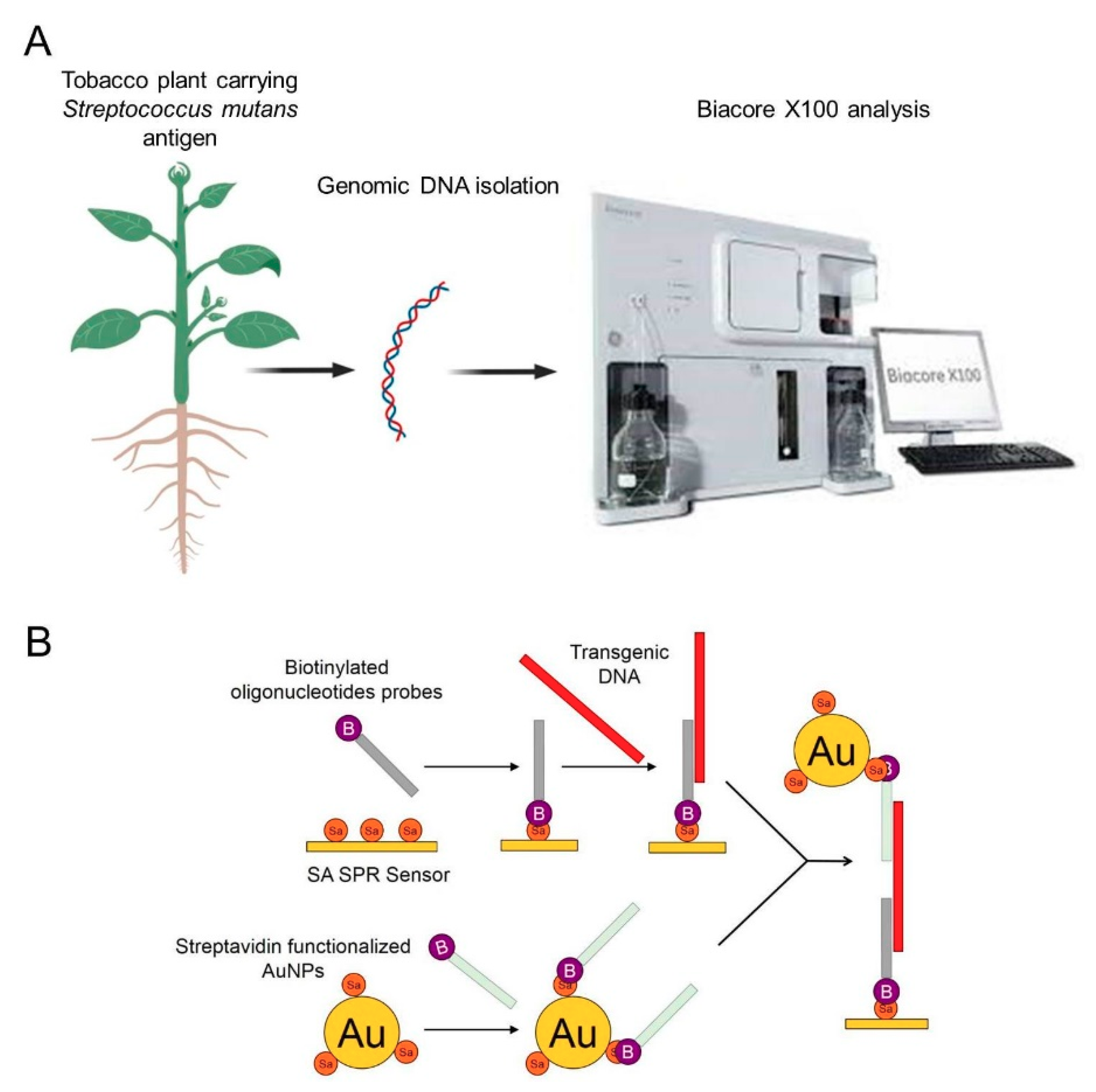
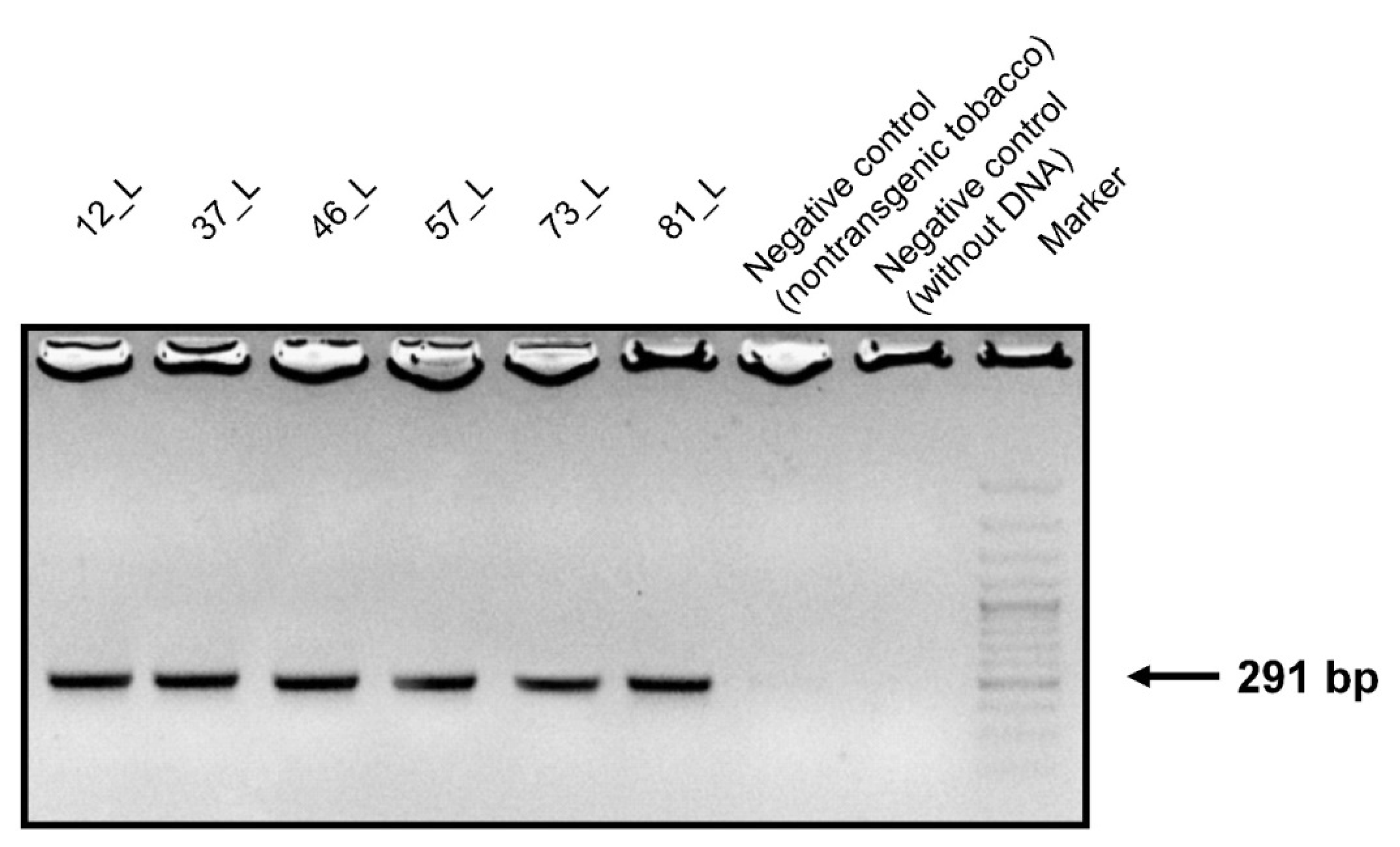
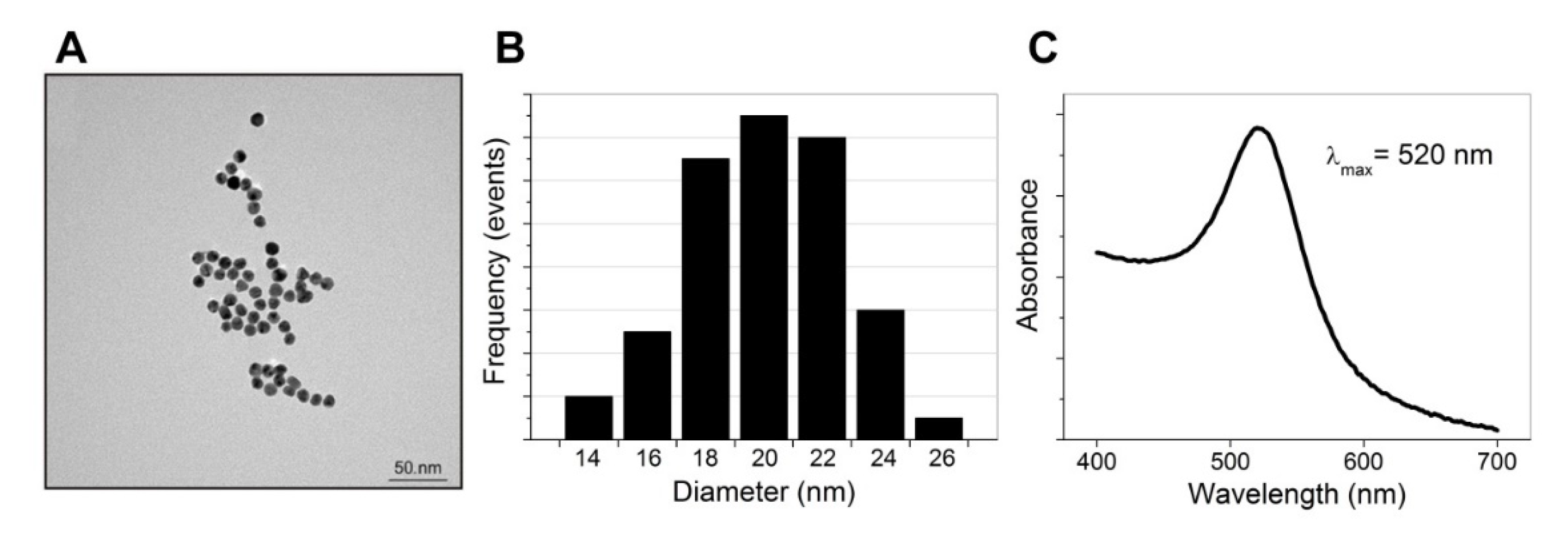
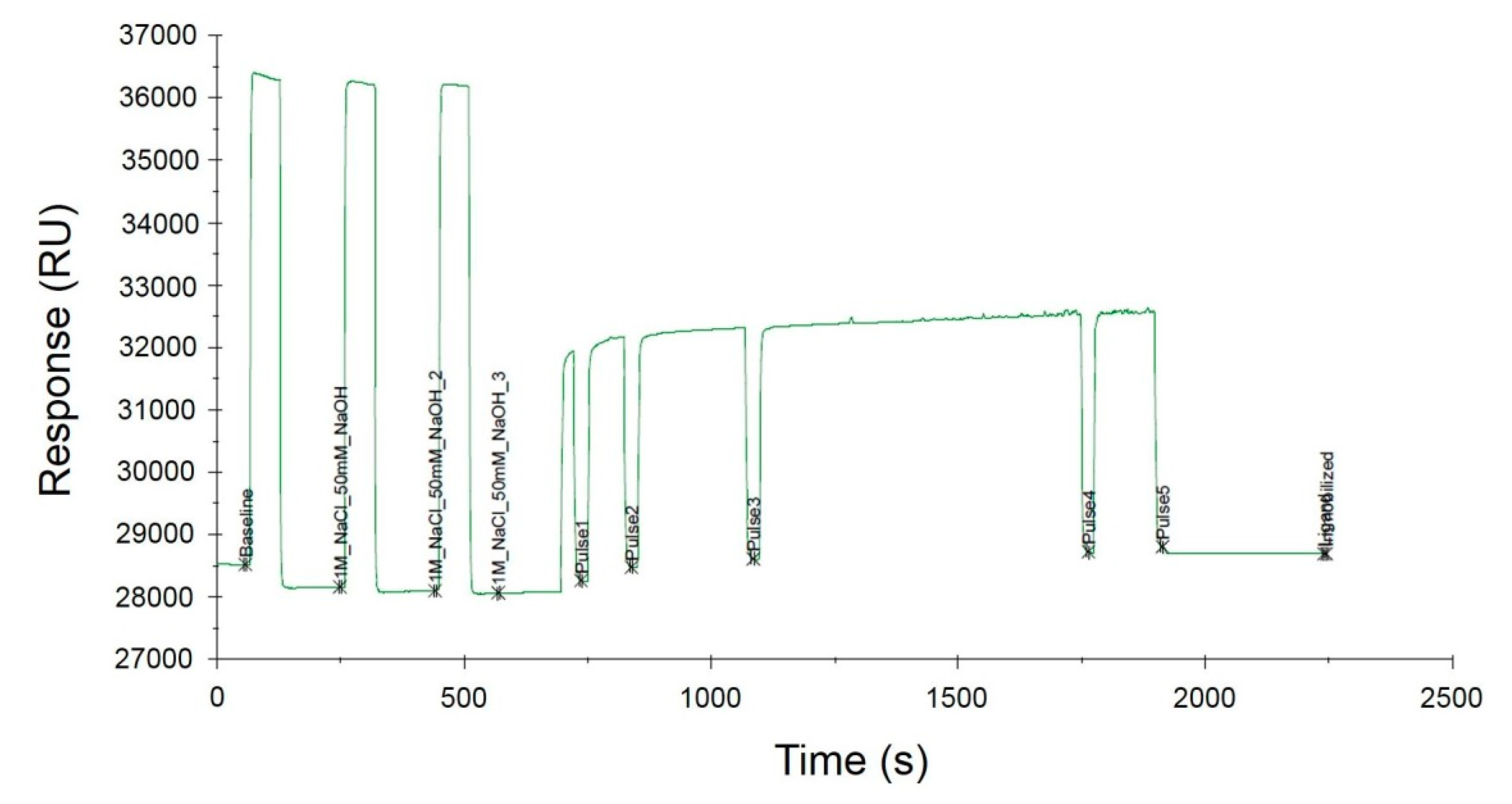
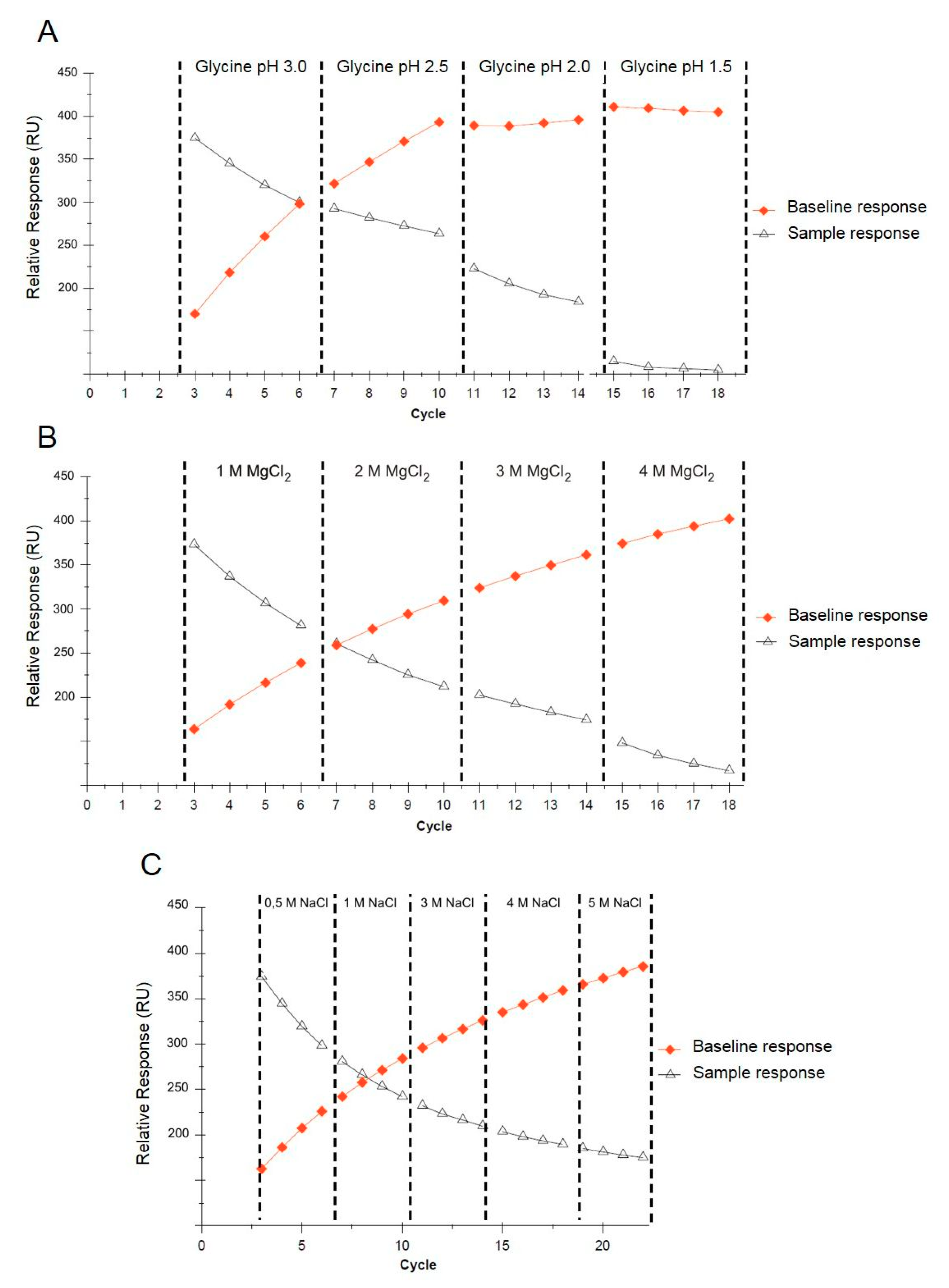
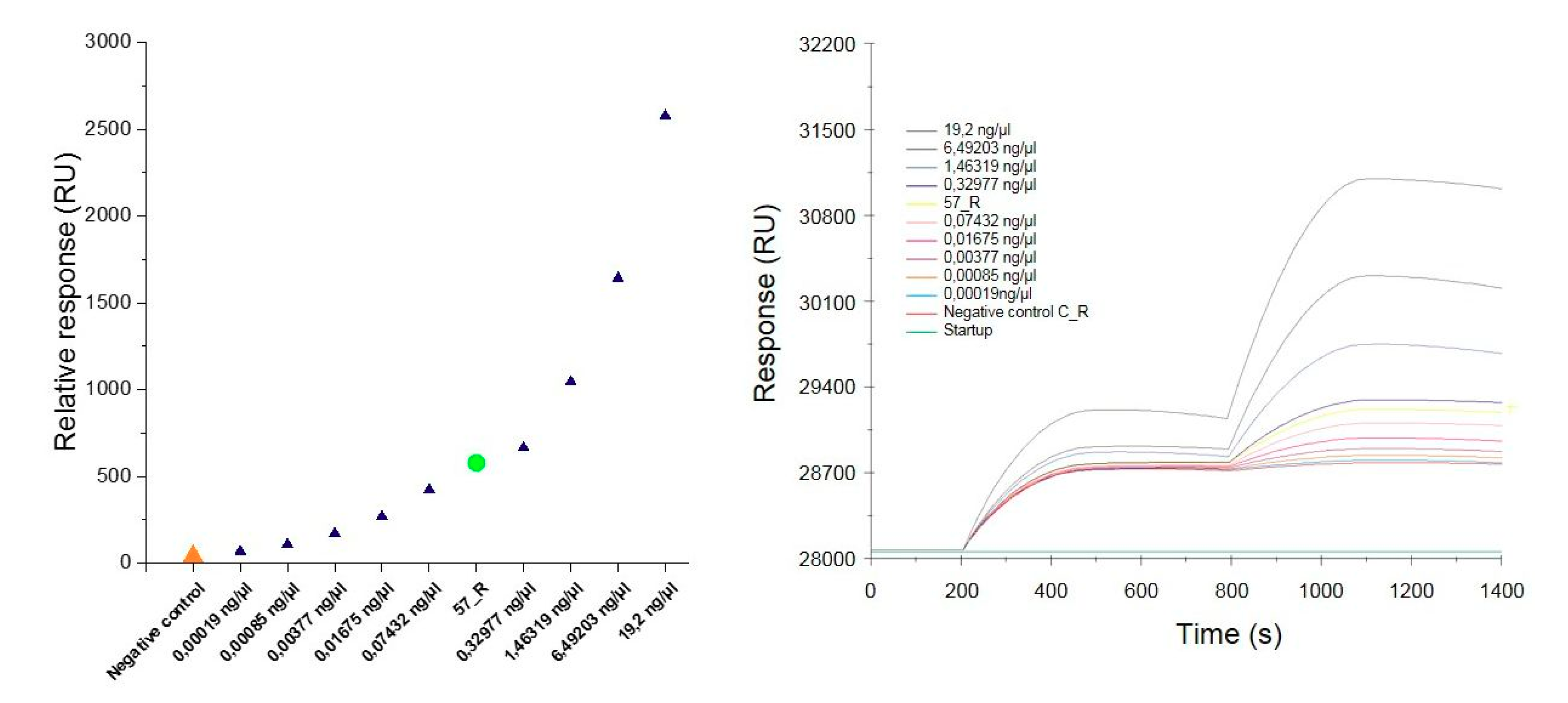
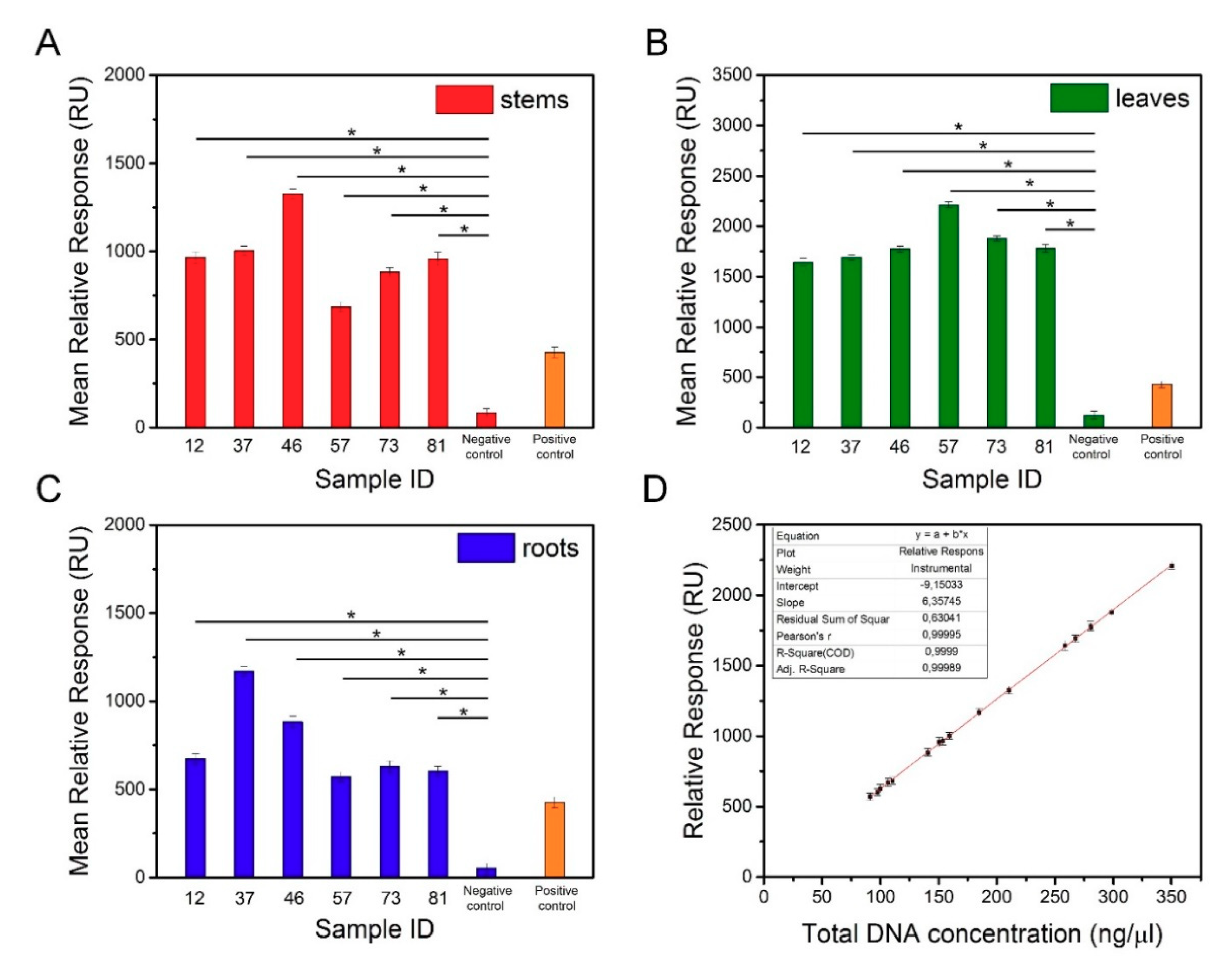
| Sequence (5’→3’) | |
|---|---|
| SA I/II F primer | TCTTGGTAGATCCCCTGCCA |
| SA I/II R primer | CAGGAGTTGTCACCCGAACA |
| SA I/II AuNPs probe | ATAAATCGTTG-Biotin |
| SA I/II SPR probe | Biotin-GTACAAGAACTTGTCC |
| Sample | Physical Diameter (nm) | Hydrodynamic Diameter (nm) | ζ-potential (mV) | PDI |
|---|---|---|---|---|
| AuNP | 20 ± 5 | 22.3 | −38.0 ± 4 | 0.090 ± 0.012 |
| AuNP-SA | - | 40.0 | −41.8 ± 4 | 0.235 ± 0.023 |
| AuNP-SA-I/II | - | 44.0 | −9.4 ± 4 | 0.331 ± 0.003 |
| Sample ID | Concentration (ng/µL) | RelResp |
|---|---|---|
| 1 | 0.00019 | 70.0 |
| 2 | 0.00085 | 109.7 |
| 3 | 0.00377 | 172.2 |
| 4 | 0.01675 | 270.3 |
| 5 | 0.07432 | 424.4 |
| 6 | 0.32977 | 666.2 |
| 7 | 1.46319 | 1045.9 |
| 8 | 6.49203 | 1641.9 |
| 9 | 19.2 | 2578.0 |
| Startup | - | 0.0 |
| C_R | 145.38 | 40.0 |
| 57_R | 90.89 | 578.5 |
| Sample ID | Concentration (ng/µL) | Mean RelResp ± SD (RU) |
|---|---|---|
| 12_S | 153.53 | 965.4 ± 28.9 1644.5 ± 35.1 672.3 ± 29.0 |
| 12_L | 258.46 | |
| 12_R | 106.57 | |
| 37_S | 158.95 | 1003.4 ± 24.9 1693.9 ± 24.9 1170.5 ± 25.1 |
| 37_L | 267.72 | |
| 37_R | 184.87 | |
| 46_S | 210.42 | 1326.1 ± 26.8 1774.1 ± 26.7 884.2 ± 28.7 |
| 46_L | 280.67 | |
| 46_R | 140.5 | |
| 57_S | 110.4 | 684.5 ± 25.5 2213.7 ± 29.5 570.8 ± 25.4 |
| 57_L | 350.21 | |
| 57_R | 90.89 | |
| 73_S | 140.85 | 883.5 ± 25.1 1879.8 ± 24.0 628.1 ± 29.4 |
| 73_L | 298.14 | |
| 73_R | 99.84 | |
| 81_S | 150.42 | 958.4 ± 32.4 1781.9 ± 33.0 602.3 ± 25.0 |
| 81_L | 280.43 | |
| 81_R | 97.21 | |
| C_S | 194.32 | 83.4 ± 23.3 125.0 ± 33.0 51.5 ± 24.7 |
| C_L | 280.83 | |
| C_R | 145.38 | |
| Positive control | 0.074 | 427.1 ± 31.0 |
© 2019 by the authors. Licensee MDPI, Basel, Switzerland. This article is an open access article distributed under the terms and conditions of the Creative Commons Attribution (CC BY) license (http://creativecommons.org/licenses/by/4.0/).
Share and Cite
Grześkowiak, B.F.; Tuśnio, K.; Woźniak, A.; Szalata, M.; Lipiński, D.; Jurga, S.; Słomski, R. Transgenic Plant Detection Using an AuNPs Based SPR Biosensor. Biosensors 2019, 9, 116. https://doi.org/10.3390/bios9040116
Grześkowiak BF, Tuśnio K, Woźniak A, Szalata M, Lipiński D, Jurga S, Słomski R. Transgenic Plant Detection Using an AuNPs Based SPR Biosensor. Biosensors. 2019; 9(4):116. https://doi.org/10.3390/bios9040116
Chicago/Turabian StyleGrześkowiak, Bartosz F., Karol Tuśnio, Anna Woźniak, Marlena Szalata, Daniel Lipiński, Stefan Jurga, and Ryszard Słomski. 2019. "Transgenic Plant Detection Using an AuNPs Based SPR Biosensor" Biosensors 9, no. 4: 116. https://doi.org/10.3390/bios9040116
APA StyleGrześkowiak, B. F., Tuśnio, K., Woźniak, A., Szalata, M., Lipiński, D., Jurga, S., & Słomski, R. (2019). Transgenic Plant Detection Using an AuNPs Based SPR Biosensor. Biosensors, 9(4), 116. https://doi.org/10.3390/bios9040116






